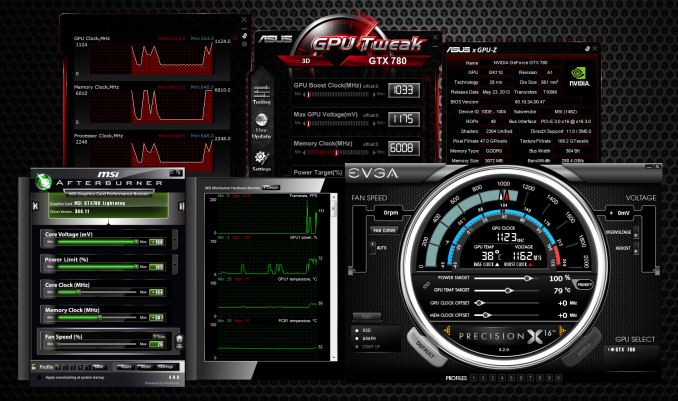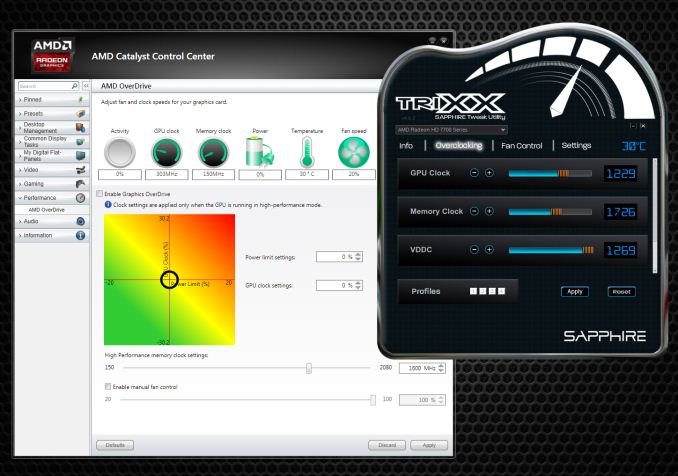The AnandTech Guide to Video Card Overclocking Software
by Michael Wilding on October 8, 2014 3:00 PM EST
Video card overclocking has become a very popular topic amongst gamers and PC enthusiasts these days. With the release of next generation games around the corner and the growing popularity of resolutions beyond 1080p, overclocking is becoming increasingly important to users looking to squeeze the most performance they can out of their video cards.
It’s been more than a decade since video card overclocking was first introduced. Back then, overclocking was considered a risky practice where only advanced users would participate. It was also looked down upon by video card manufactures and board partners alike.
Many of our seasoned readers may remember some of the more popular utilities used back in the day, such as NVMax, CoolBits, ATITools, RivaTuner, and PowerStrip. Much like today’s utilities, each had their strengths and weaknesses. Regardless of the utility used, they all had the same objective: increase the frequencies of our video cards to obtain better than stock performance. Comparing these to today’s overclocking utilities, fundamentally not much has changed. The biggest changes have to do with features and functionality, most of which can be a huge asset to users when overclocking their video cards.
Meanwhile, overclocking is no longer being shunned by video card manufactures and board partners. Instead, it's acknowledged and used in the marketing and design of many video cards, in hopes of increasing market share and brand reputation. Due to the popularity of overclocking, board partners have embraced these utilities and begun to develop them on their own. Along with developing these utilities, board partners have been marketing custom cooled and factory overclocked models to help increase profit margins, and to help broaden their product offerings as well. Additionally, video cards manufactures have been implementing safety measures to prevent users from easily damaging their video cards. Safety nets, such as the use of dynamic clock speeds and GPU throttling, have made overclocking safer and more accessible to the average user.
This article will not be a guide on how to overclock your video card; instead, we'll be doing a round-up of the utilities that help make overclocking possible. Overclocking with the use of software utilities continues to be the most popular method to date. There are over a dozen utilities that can be used to overclock today’s video cards, but today we'll only be looking at the most popular within our community. These utilities include AMD OverDrive, Sapphire TriXX, ASUS GPU Tweak, EVGA Precision X, and MSI Afterburner. As we delve into these utilities, we’ll be analyzing each of their strengths and weaknesses and discovering what separates them from each other as well. Hopefully this round-up will provide some useful data and help you decide which utility is right for you.











59 Comments
View All Comments
stryderxx - Thursday, October 9, 2014 - link
I see that the author of the article didn't mention the fact that EVGA's Precision X 16 causes DirectX overlay and crash issues. Games like Diablo 3 are unplayable while using this software.Michael Wilding - Thursday, October 9, 2014 - link
I was curious, so I fired up Diablo 3 with the Precision X 16 OSD enabled and had zero issues. Maybe the recent update fixed this issue?madwolfa - Thursday, October 9, 2014 - link
OSD in EVGA Precision X 16 is very problematic, causing issues with many games. Installed MSI Afterburner and couldn't be happier - back to rock solid RivaTuner performance.garrun - Thursday, October 9, 2014 - link
This was a really helpful article. I've been using PrecisionX 16 with my GTX 980's and didn't realize it could do all of that. Very cool.Subyman - Thursday, October 9, 2014 - link
I like EVGA's application, but I do not like how they chose form over function. The readability of the "LCD looking" font is really poor. I wish they had a setting's window like MSI's does instead of a tiny imitation of a AV receiver's display on the application. Having to click the right and left arrow to move through options is a perfect example of imitative fallacy.hulu - Thursday, October 9, 2014 - link
I'd guess the Battlefield 4 exclusion rule is there because "Origin In-Game" (the Origin overlay) doesn't play nice with other OSD programs in 64-bit. Using multiple 64-bit OSDs causes games to run at ~1 fps.LoccOtHaN - Thursday, October 9, 2014 - link
Im using TRIXX only :DLedHed - Friday, October 10, 2014 - link
This seems eerily similar to my own article, except we got an exclusive interview with the creator of RivaTuner (which powers Afterburner and Precision X) and it was out almost a year earlier.http://videocardz.com/35604/gpu-overclocking-apps-...
I was thinking of doing an updated version with the newest versions/features, but I guess there is no need now. You also came to the same conclusion as I did, along with Alexey Nicolaychuk's choice also.
Michael Wilding - Friday, October 10, 2014 - link
Many articles cover these utilities. Our goal was to provide an in-depth analysis of each, so users can make an educated decision when selecting a utility.LedHed - Friday, October 10, 2014 - link
I wasn't saying anything negative about you writing this, I actually kind of found it funny because I had to pitch the idea the webmaster of VC and at first it almost wasn't written until I brought Alexey into it.